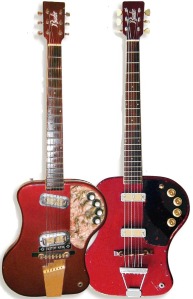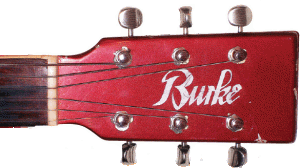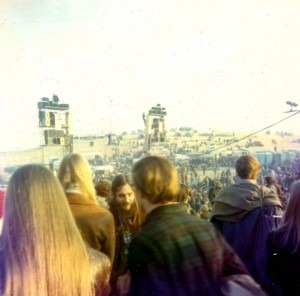Here is an article we contributed to by Ward Meeker for the April 2012 edition of Vintage Guitar Magazine.
The first “Aluminum Neck Guitar” built by Glen Burke

The Gibson-esque “Custom” plate, DeArmond pickup, and Grestch Space Control roller bridge on Mat Rile’s Burke.
For more than 60 years, aluminum has been used as a component in guitar construction. Exactly whose idea it was originally has never been a cut-and-dried matter of fact, but has amply provided cud for the world’s guitar animals to chew upon. In his November 04 column “The Different Strummer: Al-u-minium!,” VG contributor Michael Wright offered an in-depth look at the use of aluminum as a structural element in guitars, noting how it was seen as a solution to the inherent instability of wood necks, with the occasional exception when it was used to render different tones.
Once upon a time, of course, stringed instruments were made only of wood and were strung with gut’. As Wright points out, the adoption of steel strings began after the mandolin in was introduced to America in 1880, and as more mando — and guitar — players transitioned to steel strings, the necks, bridges, and bellies of their instruments began to suffer the consequences of the inherently higher tension. The solution was Wright recalled, “.,.the trapeze tailpiece, [which relieved] stress [from] the belly and bridge. By the 20th centurc guitars were made with pin bridges for gut and trapezes for steel.” The next game-changing use of metal came with the truss rod, which by the ‘30s was common.
John Beauchamp and Adolph Rickenbacher were the first builders to use aluminum as a primary element in the construction of an instrument when, in 1931, they devised the all-aluminum A-22 Hawaiian guitar – a lap-steel.
As a means to stabilize the neck of a Spanish-style guitar, credit has traditionally gone to Italian artist Wandré Pioli (whom Wright featured in the November and December ’99 issues of VG), an archi- tectural engineer who loved motorcycles and began designing guitars in the mid 1950s; in’59, he began using a flat-faced, semi-circular aluminum bar as a neck, with a rosewood fingerboard glued to its face and a back formed with molded PVC.
“Pioli employed three neck designs,” said Wright. “One was a traditional bolt-on, but most intriguing was a neck- through concept with the aluminum extending to a chevron-style [tailpiece].” Later builders who employed aluminum necks included Jacobacci, in Paris, and Messenger, which was founded in the late ‘60sby Bert Casey and Arnold Curtis in San Francisco. John Veleno, a guitar player/teacher and machinist whose day gig was in a machine shop that made aluminum electrical housings used in early rockets, began building guitars in ‘66 using necks cast of Almag 35, an aluminum/magnesium alloy. They were the only axes of the bunch to use an aluminum fingerboard. Travis Bean, another motorcycle enthusiast, used aluminum necks to avoid wood-related twisting on his koa-bodied guitars, which were known for them machined “T” cutout on the headstock. Bean necks have a chunk of aluminum at the end which served as a heelbiock, solidifying the neck-to-body joint.
The most commercially successful use of aluminum necks happened with Kramer guitars, which originally sought to improve on the Bean concept: Gary Kramer and Dennis Berardi used a T-bar, with the top of the T taking the fingerboard, and their headstock had a wishbone shape very similar to Bean’s T but without the top bar. Kramer necks have two wooden inserts plugged into the sides of the Tstem, so the only aluminum the player feds is a narrow strip along the back. By ‘81, though, wood necks had all but supplanted aluminum at Kramer. Beyond that, a few guitar hardcores might remember a brand called Hustler, which used aluminum necks and were promoted briefly in mid ‘79.
Recently, however, the emergence of two unique instruments has thrown guitar history yet another curveball…
“Before the Messenger, before Kramer, before Veleno and Travis Bean, there was the Burke guitar,” said Mick Flynn, a guitar dealer in Kirkland, Washington, who recently got a call from a man who had found an unusual instrument at a Goodwill store in nearby Eugene, Oregon. Having no idea what it was, the man took it to a big-box music store, where, Flynn said, “A manager identified it as a homemade guitar that was ‘worthless and should be burned!’ And yes, that’s exactly what they told him!”
Rightfully miffed at the ignorance displayed by the big-box guy) the man began researching the brand online, where he found a snippet on the website belonging to Flynn’s store, Guitar Archeology; it turns out that after finding a Messenger guitar, Flynn and his staff did some leg work to find out what it was. Then, “We posted pictures and told everything we knew about the guitar” Flynn said. “There was a lot of interest”
Then, Flynn got an e-mail that started with the cryptic passage, “So the myth continues…”
The note came from Colleen Pulley, whose father, a former area resident named Glen Burke, had designed an aluminum – necked guitar well prior to the introduction of the Messenger. And she wanted to set the record straight!
“I am surprised more people haven’t realized the Tuning Fork Guitar Company preceded the Messenger guitar by at least eight years,” she told Flynn. “I think it’s time my father is given credit.”
Tuning Fork Guitar Company? Flynn was curious. So he started once again to dig, beginning with a contact offered by Pulley – Daniel LeBlanc, a one-time sales rep for the company.
LeBlanc told Flynn how Tuning Fork Guitar was founded by Burke and based on a ”kit guitar” that gather sourced parts to “bolt” to an aluminum neck that attached to wooden body segments.
“I met Burke in late April of 1965,” said LeBlanc. “At the time, I was employed as a security guard at the Tongue Point Job Corps in Astoria, Oregon, and Glen was instructing students there on how to construct guitars using his Tuning Fork kits. The students loved building the guitars, and because of the aluminum neck, they sounded great.”

(LEFT) The Burke guitar belonging to Mat Rile. (RIGHT) The Burke discovered in Oregon and documented by Mick Flynn.
LeBlanc’s relationship with Burke evolved to the point where the former quit his job to work as a distributor for Burke, focused on Oregon, Washington, Idaho, and Alaska. The two conducted sales presentations and bought parts — fretboards, strings, bridges, pickups, etc. In ’66, Burke moved the company to Grants Pass, Oregon. There, LeBlanc would compile the parts to make kits, and assemble some to sell as completed guitars. And though both were dedicated to the effort they soon faced significant hurdles. I can remember going with Glen to purchase parts at a large music outlet in Portland, LeBlanc said. “Glen was talking to the owner while I looked around. Then, he asked me to wait outside while he talked to the guy. Later, he told me how the shop owner told him word had come down from two large American guitar manufacturers, instructing him not to sell parts to Glen.”
The development all but halted Burke’s operation, and within a few months LeBlanc was forced to move his family and find work in California. To this day, he’s saddened by the story because as he saw it, Burke poured his heart and soul into the effort, and LeBlanc himself saw — and still sees — so much potential in Burke’s concept.
‘When the students at Tongue Point built the guitars, you could see the excitement, the pride, and the sense of accomplishment they had when ‘their guitar’ was finished. Glen’s vision was to see the same thing happen everywhere – people all over the world building their guitars and playing their music.”
In their short run, LeBlanc recalls that most of the Burkes assembled were six-string guitars, along with several 12-stings. And because they could be dressed with whatever finish the builder wanted, he saw instruments in everything from standard paint to odd variations like cowhide and tooled-leather coverings. Their common element, of course, was the neck shown in the drawings for the 1960 patent with, as described in the filing “…a hollow aluminum neck which extends entirely through the guitar to the base and has the body portion attached to the sides thereof.” The illustration shows the topless aluminum box that made up the neck-through element.
“Before we got thee-mail from Colleen Pulley, I had never heard of Burke guitars, and neither had anyone l knew here in the Pacific Northwest, said Flynn. “But while doing the research so we could put the bit on our website, I found Glen’s patent filing. Within six months of posting everything we were contacted by the couple who found the guitar at Goodwill.”
Soon after that contact, Flynn made his way to Eugene, where he expected to simply pay a visit to one very rare bird of a guitar. But.. “When we got there, it had been taken apart,” he recalled, such a scenario can be a dealer’s worst nightmare, but this time, it was key to a pleasant surprise. “I could read what was written inside—and it was amazing!” There, written in pencil on the wooden back of the instrument, between the aluminum forks, were the words, “Built March 8, 1960, to last until 2060. Builder Glen F Burke, 4025 E 17 Ave. Eugene, Oregon.” Then, inside the bass bout, it says, “When this is opened, I’ll probably be long gone from the worries of the world, so if you’ve had good luck with this guitar, you can wish me good luck wherever I am. G.F.B.”
“We believe this is one of Glen’s first guitars – if not very first, given that it pre-dates, by five months, the patent filing,” Flynn said.
So, what’s it like to hold and play a Burke?
“It has a very unique tone, completely unlike any other guitar,” Flynn noted. “It’s very resonant and bright, but not brittle. Chords sound full and rich. It really is a shame they weren’t given a chance to catch on, commercially.”
Another Burke owner is Matt Rile, in Toluca Lake, California; his weighs just thy of eight pounds. “It’s very light compared to similar instruments by Messenger, Travis Bean, or Kramer,” Rile said. “Its gold- foil DeArmond pickups are amazing. The output on both read almost 12K, and they can cover many genres of music, from country / rockabilly to rock, with distinct twang. When driven, it can also get real nasty yet maintain full character. Also because the body is hollow, it possesses a banjo-like acoustic tone, which you’d never expect. The bottom line is, it sounds so good!”
Rile’s guitar has a master Volume and master Tone controls and a three-way toggle switch. “The pickguard assembly is unique) he points out. “The pickguard has no screw holes. It’s mounted to four pots and the switch, as they’re routed through holes inside the body, then they’re attached to the pickguard, secured with a nut and washer.”
Three “extra” holes under each pickup indicate Burke (or someone else) experimented with pickup placement The DeArmond pickups on Rile’s guitar have goldfoil-inlaid coves, a DeArmond wiring harness, CTS pots, Switchcraft jack, Valco tailpiece (with custom gold coloring), Gibson control knobs and switch caps, Kluson tuners, a “Custom Made” plaque as seen on certain Gibson models and a gold-colored Grestch Space Control roller bridge.
Though Burke’s body shape is nontraditional — even odd — Rile says the guitar is comfy to play. “lt’s designed very well, and is actually quite comfortable and fits the player’s body:’ he noted “Even better, it fits like a glove when you’re sitting down.”
The guitar’s scale measures 257/8” and Rile describes its neck profile as a “meaty/mild D shape,” and as one might expect, “The aluminum gives it a totally different feel and truly plays fantastic, with a neck angle that results in a real player instrument, like all the desired brands of yesteryear.
“I’ve owned many rare aluminum- neck guitars in the past – Davoli/Wandre, Messenger, Ve!eno, TravisBean and even top-of-the-line Kramers,”he adds. “But nothing plays or sounds similar to this instrument, either in terms of natural acoustic projection or plugged-in tone. If you ask me, Burke was the Picasso of guitars.”
“I’ve often wondered what might have happened if Glen had better luck’ added LeBlanc. “What if he had been able to overcome those who kept him from succeeding? And regardless, the industry should recognize Glen and the Tuning Fork Guitar. It was Glen’s idea, which he patented, worked, and sacrificed for! If I had the resources, I’d bring it back myself.”






